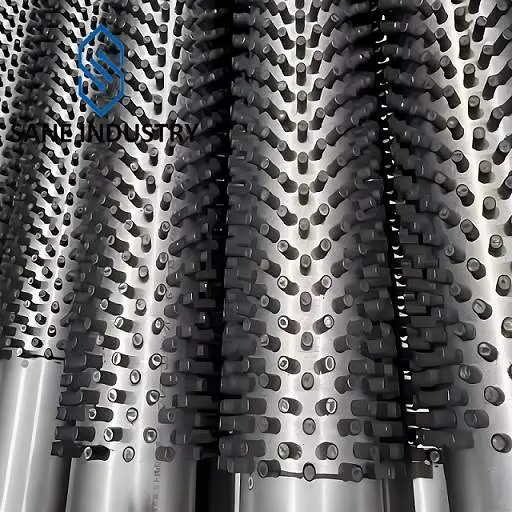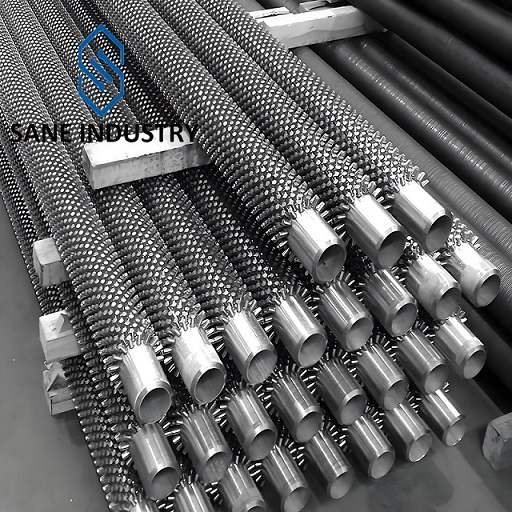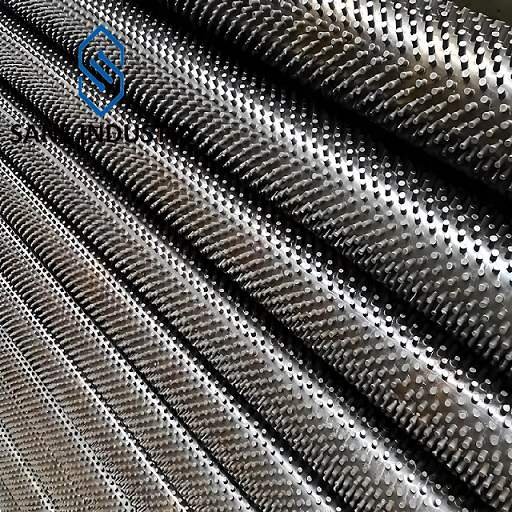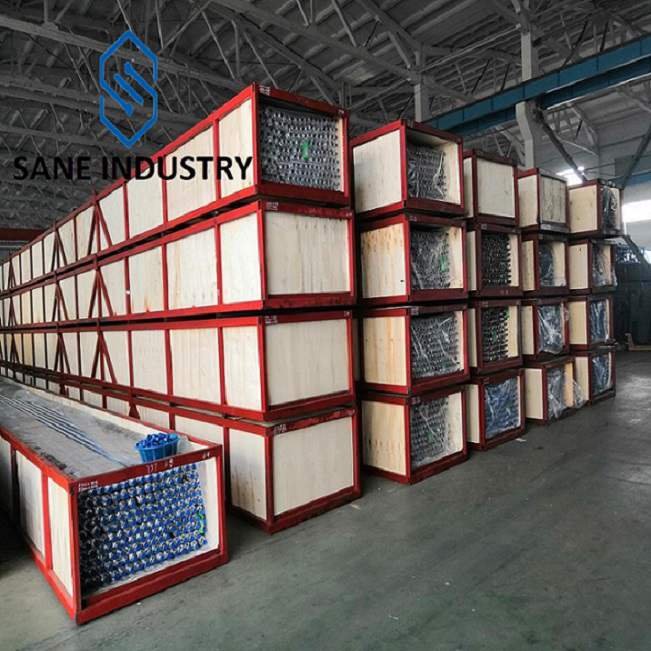What is a Studded Tube
A studded tube(studded pipe) is a specialized heat transfer component designed to enhance thermal efficiency in high-temperature or high-fouling environments. Unlike finned tubes, which use continuous metal strips, studded tubes feature discrete studs (small cylindrical or conical protrusions) welded to the base tube’s surface. These studs increase the surface area and turbulence, improving heat exchange while resisting debris buildup.
The Key Features of Studded Tubes
Structure:
- Base Tube: Typically carbon steel pipes, stainless steel pipes, or alloy steel pipes (e.g., Inconel® for extreme conditions).
- Studs: Small metal projections welded radially or in patterns to the tube surface.
- Bonding Method: Studs are welded using resistance welding, arc welding, or high-frequency (HF) techniques for durability.
How It Works:
- Studs disrupt fluid/gas flow, creating turbulence that breaks thermal boundary layers.
- Increased surface area and turbulence boost heat transfer by 15-25% compared to smooth tubes.
The Manufacturing Process of Studded Tubes
Material Preparation
- Base tube: Selected based on application (carbon steel, stainless steel, or alloys), cut to specified lengths, and cleaned to remove surface contaminants.
- Studs: Cold-formed from ductile metal rods (steel, aluminum) to precise dimensions (diameter: 6–15 mm, length: 8–50 mm).
Stud Resistance Welding
- Automated systems position studs on the tube surface in pre-programmed patterns (helical, grid).
- High-current electrical pulses generate localized heat, fusing stud bases to the tube without filler material.
- Parameters controlled (voltage: 5–15 V, pressure: 50–150 N) to ensure weld integrity and avoid base tube deformation.
The Advantages of Studded Tubes
Enhanced Heat Transfer
- Increased surface area (up to 3x vs. smooth tubes) and induced turbulence improve convective heat exchange efficiency.
Structural Durability
- Welded studs resist vibration and thermal stress, maintaining integrity in high-pressure (>50 bar) and high-temperature (>500°C) environments.
Anti-Fouling Capability
- Self-cleaning design minimizes particulate buildup through turbulence and stud-induced vibrations.
Material Flexibility
- Compatible with carbon steel, stainless steel, and alloys for corrosion resistance or cost optimization.
Space Efficiency
- Compact design delivers superior thermal performance per unit volume, reducing equipment footprint.
Low Maintenance
- Robust construction and fouling resistance decrease downtime and operational costs.
The Disadvantages of Studded Tubes
Higher Manufacturing Costs
- Precision welding processes and material requirements raise production expenses compared to smooth tubes.
Pressure Drop Increase
- Turbulence from studs elevates flow resistance, demanding stronger pumps or compressors in fluid systems.
Fouling Risks in Specific Fluids
- Susceptible to clogging with viscous fluids (e.g., heavy oils) or particulate-laden media, reducing efficiency over time.
Complex Maintenance
- Difficult to clean internally if fouled; specialized tools/techniques may be required.
Limited Material Compatibility
- High-temperature stud welding restricts base-tube/stud material pairings, limiting corrosion-resistant options.
Weight Increase
- Added stud mass raises overall tube weight, impacting installation and structural support needs.
Sizes and Materials of Our Studded Tubes
| Base Tube Diameter | 25 to 350 mm | 1/2″ to 14″ NPS |
| Base Tube Wall Thickness | 3 to 25 mm | 0.11″ to 1″ |
| Base Tube Length | ≤32,000 mm | ≤92 ft |
| Base Tube Material | Carbon Steel (A106B, P235GH, A179, A210, A192, etc.) Alloy Steel (P5, T5, P9, T9, T11, T22, etc.) Stainless Steel (TP304, TP316, TP347, B407 800H/HT, etc.) | |
| Stud Pitch | 10 to 35 mm | 0.39″ to 1.38″ |
| Stud Height | 8 to 50 mm | 0.31″ to 1.97″ |
| Stud Diameter | 6 to 15 mm | 0.23″ to 0.6″ |
| Stud Material | Carbon Steel, 2.25Cr-1Mo, 5Cr-0.5Mo, 11-13Cr (409, 410), 18Cr-8Ni (SS 304), 25Cr-20Ni | |
| Stud Shape | Cylindrical, Elliptical, Lens type | |
For other customized requirements, please contact us.
What is the Price of Studded Tubes
Please contact our sales manager Allen@sanesteel.com.
Our Production Capacity of Studded Tubes
Total four automatic ERW studded tube machines. Monthly production capacity is 5,000,000 studs in total.
Studded Tubes Uses
High-Pressure Boilers
- Studded tubes can optimize heat transfer in steam generation systems while resisting thermal fatigue and vibration.
Petrochemical Reactors
- Studded tubes can enhance catalytic reaction efficiency in corrosion-prone environments (e.g., hydrogen crackers, reformers).
Waste Heat Recovery Units
- Studded tubes can capture energy from flue gases (up to 900°C) in refineries or power plants with minimal fouling.
Fluidized Bed Reactors
- Studded tubes can improve heat distribution in coal gasification or biomass processing with abrasive media.
Cryogenic Heat Exchangers
- Studded tubes can maintain structural stability in LNG processing under extreme thermal gradients.
Desalination Systems
- Studded tubes can resist scaling and corrosion in multi-stage flash (MSF) evaporators handling seawater.
Incinerators
- Studded tubes can withstand aggressive combustion byproducts (e.g., acids, particulates) in waste-to-energy plants.
Studded tubes are ideal for high-temperature, high-pressure, or corrosive environments requiring robust thermal performance and longevity.
Studded Tubes Cleaning
Studded tubes are specialized heat transfer components with surface protrusions designed to enhance thermal efficiency. Their unique geometry requires tailored cleaning approaches to maintain performance and prevent fouling. Below are key considerations and methods for effective maintenance:
1. Cleaning Methods
- Mechanical Scrubbing: Use tube cleaning tools (e.g., rotary brushes or scrapers) compatible with studded surfaces to dislodge debris without damaging protrusions.
- High-Pressure Water Jet: Effective for removing scale and particulate buildup between studs, particularly in industrial boilers or heat exchangers.
- Chemical Cleaning: Apply solvent-based solutions (e.g., acidic or alkaline cleaners) to dissolve stubborn deposits. Verify compatibility with tube material (e.g., carbon steel or alloy).
2. Specialized Equipment
- Tube Cleaners: Select flexible, abrasion-resistant tools (e.g., nylon brushes) to navigate studded geometries.
- Automated Systems: For large-scale applications, consider robotic or ultrasonic cleaning devices to ensure uniform coverage.
3. Preventive Measures
- Regular Inspection: Monitor fouling patterns around studs to optimize cleaning frequency.
- Material Selection: Use corrosion-resistant studded tubes in high-fouling environments to reduce maintenance demands.
Comparison with Finned Tubes
| Feature | Studded Tubes | Finned Tubes |
|---|---|---|
| Surface Design | Discrete studs | Continuous fins (solid/serrated) |
| Fouling Resistance | ⭐⭐⭐⭐⭐ | ⭐⭐⭐ |
| Heat Transfer | Moderate-to-high | High (depends on fin type) |
| Durability | Excellent in abrasive environments | Good, but fins can bend/damage |
| Pressure Drop | Lower than serrated fins | Higher (due to dense fin spacing) |
Why Choose Us
- a 16-year studded tube manufacturer. We are experts.
- solutions for all your needs
- the highest product quality
- the low lead times
- excellent customer service




